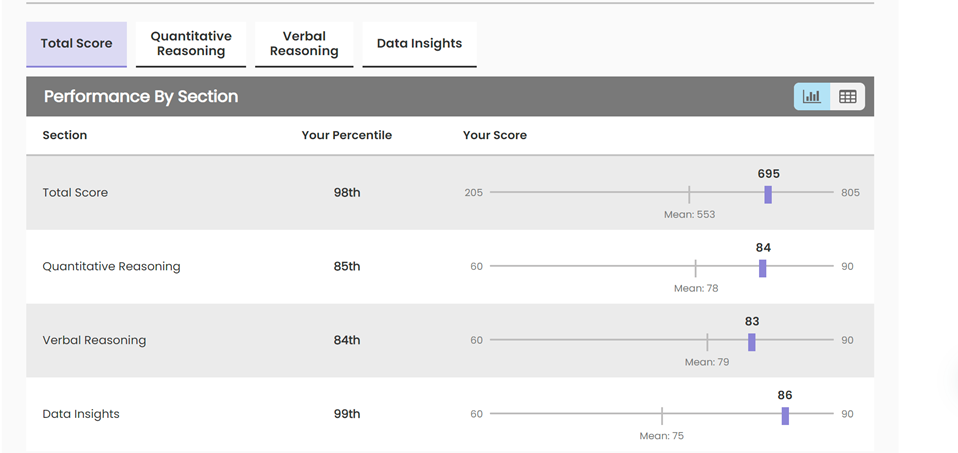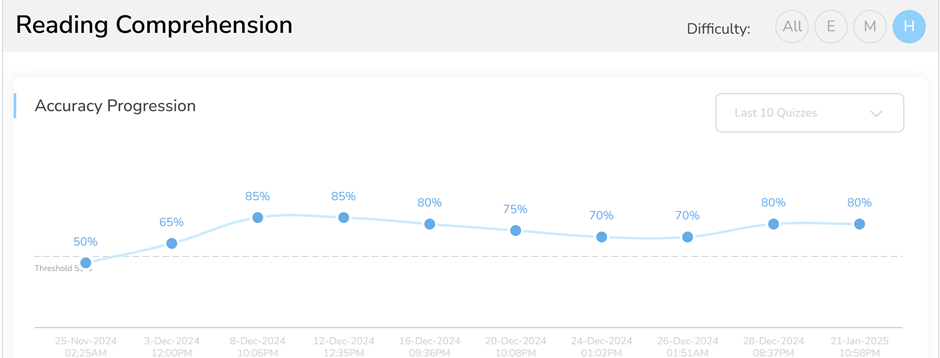Hello GMAT Club Members,

I'm sharing my GMAT journey to 695 today hoping it might help others facing similar challenges along their GMAT path. My journey to a 695 took persistence, structured preparation, and the right guidance. After five years and four attempts, I finally achieved my target score. Through this debrief, I want to share the strategies and insights that made a difference in my preparation.
Previous Attempts and Challenges:My initial attempts at the GMAT Classic were a series of learning experiences, each revealing different aspects that needed improvement.
- Attempt 1 (May'23): 660 (Q47, V34)
- Attempt 2 (Oct'23): 670 (Q49, V33)
- Attempt 3 (May'24): 645 (Q86, DI79, V80)
These attempts helped me identify several key challenges that I needed to overcome. My verbal scores were stuck at 33-34 even after lots of practice and the sentence correction was a nightmare. My mock scores were also highly inconsistent with the scores maxing out at 640. Also, previously as IR was optional, I did not study much for it. Additionally test day anxiety also used to affect the overall performance. While these challenges seemed daunting, they also helped me realize that I needed a completely different approach to crack the GMAT. The transition to the GMAT Focus Edition with the elimination of SC gave me the opportunity to make a fresh start. But this time there was a new challenge with the introduction of the DI Section.
GMAT 695 in the Fourth Attempt – What changed?Previously, I scored a 645 doing only self prep. Around this time, I took the first sigma mock test with
e-GMAT and got a 655. Seeing my performance, when Rashmi mam from
e-GMAT reached out to discuss their
Last Mile Push program, I was initially skeptical. After all, I had already exhausted various preparation methods. However, our discussion about my previous attempts and challenges made me realize there were significant gaps in my preparation approach that needed addressing.
The structure of Last Mile Push program intrigued me - it wasn't just about practice questions but offered a comprehensive strategy tailored to my strengths and weaknesses. What particularly caught my attention was their data-driven approach to improvement and the promise of personalized mentorship throughout the journey. The program proved invaluable - providing not just the structural support I needed but also the psychological boost that comes from having someone believe in your potential. Having weekly milestones and regular feedback helped me stay on track and maintain momentum.
We followed different strategies for each section based on my ability levels at that time.
For Verbal and DI, where I needed significant improvement, we implemented a rigorous three-staged approach:
1. Concept Building Stage:- Completed the entire course curriculum systematically
- Focused on understanding fundamental principles and approaches
- Built a strong foundation before moving to practice
- Learned key strategies like "owning the dataset" for DI and pre-thinking for CR
2. Cementing Stage:- Focused practice with medium and hard level questions
- Regular error analysis to identify patterns
- Worked on improving both accuracy and timing
- Used custom quizzes to target specific weaknesses
3. Test Readiness Stage:- Regular sectional mocks to simulate test conditions
- Worked on maintaining performance under time pressure
- Focused on achieving consistent accuracy levels
- Built stamina for handling back-to-back questions
For Quant, since I was already performing well, we took a different fast paced approach:
- Weekly sectional tests to maintain ability
- Focus on time management and accuracy
- Regular performance tracking to ensure consistency
DI – From DI79 to DI86:My journey with Data Insights was particularly interesting. Starting with a DI79 in my last attempt, I was already performing decently, but I knew I needed to push further for a top score. The initial challenges were time management across the different question types, difficulty in handling multiple data sources efficiently, finding myself re-reading data multiple times, Struggling with verbal-heavy DI questions especially MSR due to my reading challenges.
The game-changer was
e-GMAT's "
owning the dataset" approach. This approach emphasized thoroughly understanding and analyzing data before attempting questions. Instead of jumping into questions and referring back to data repeatedly, I learned to read the data carefully and systematically, analyze relationships and patterns, note down key insights and connections, and create a mental map of where different information was located.
For example, in MSR questions, this systematic approach transformed how I handled multiple tabs. I would thoroughly read and analyze the first two tabs, taking comprehensive notes of key information, and keep only the third tab open for reference. This eliminated the need to switch between tabs constantly.
This approach transformed my performance across all DI question types. My accuracy improved to 80%+ on hard questions, while my time per question reduced significantly. I gained confidence in handling complex data sets, which ultimately led to achieving DI86 (99th percentile).
Conquering the Verbal ChallengeEven though my starting Verbal score on Focus Edition was 80, I wasn't confident about my verbal abilities. Having struggled with reading throughout my academic life, I knew I needed a strong foundation to maintain consistent performance.
e-GMAT's
pre-thinking approach in Critical Reasoning became my strongest ally. The course taught me to analyze arguments systematically before looking at answer choices. I learned to break down arguments, identify conclusions, and predict possible answers. This structured approach helped me avoid getting trapped between two seemingly correct options – a problem that had plagued my previous attempts. By following this process, my accuracy on hard CR questions improved to over 60%.
For Reading Comprehension,
e-GMAT's reading strategies transformed my approach. The course taught me to read actively, processing each paragraph individually while understanding the author's purpose and message, and then, connecting how each paragraph contributed to the overall passage. These strategies turned RC from my weakest link to a section I could approach confidently. My accuracy on hard passages improved from 35% to 80%, with a significant reduction in reading time.
 Maintaining Quant Performance
Maintaining Quant PerformanceGiven my engineering background and natural comfort with numbers, Quant had always been my strong suit. In my sectional mocks, I was consistently scoring well, usually hitting Q86-Q88. I maintained this performance through regular sectional tests, focusing mainly on accuracy and time management. However, on test day, things didn't go as planned. I encountered some particularly challenging questions early in the section, and despite my strong preparation, my Quant score dropped. Looking back, I believe this was partly due to rushing through some questions and not following the methodical approach I had practiced.
This experience taught me an important lesson - even in your strongest section, it's crucial to:
- Maintain focus on each question
- Avoid rushing even when under pressure
- Double-check work when time permits
- Stay calm if you encounter difficult questions early
Mock Test JourneyThe mock test phase was a crucial part of my preparation. After completing my sectional preparation, I focused on full-length mocks to build stamina and test readiness. Here's how my mock scores progressed:

My SIGMA-X mock scores almost predicted by final GMAT score😊. The mock phase also helped me develop better stamina for the actual test. I learned to:
- Manage my energy across all sections
- Use breaks strategically
- Stay focused despite fatigue
- Maintain composure when facing challenging questions
Test Day Experience: Managing AnxietyAs someone who had struggled with test anxiety across three previous attempts, I knew managing my nerves would be crucial for my fourth attempt. But this time was different - I felt more prepared than ever, yet the weight of previous disappointments was still there. What really helped me stay calm was focusing on one question at a time. I made a conscious decision not to think about my previous attempts, not to worry about the section I had just completed, or even the question I had just answered. My entire world became just the question on my screen at that moment. This mindset proved invaluable when my Quant section didn't go as planned. In previous attempts, a challenging section would have derailed my entire performance. This time, I reminded myself to move forward and focus on what was ahead. Taking my scheduled break after Quant helped me reset mentally before tackling the remaining sections.
Throughout the test, I kept returning to what Rashmi mam had emphasized - trust your preparation, stay present, and keep moving forward. This approach helped me maintain composure and ultimately achieve my target score, even though the journey through the test wasn't exactly as I had envisioned.
Resources that Made a Difference:e-GMAT was instrumental in my success, particularly through:
- The Last Mile Push program with personalized mentorship
- Comprehensive course content for Verbal and DI
- Cementing quizzes for focused practice
- Scholaranium's adaptive question bank
- Regular performance analytics to track progress
Key Learnings for Future Test-TakersLooking back at my five-year journey, here are the insights that I believe could help other GMAT aspirants:
1. Quality Over Quantity: It's not about how many hours you study but how effectively you use them. Strategic, focused practice with proper review yields better results than countless hours of unfocused preparation.
2. Trust the Process: Follow a structured approach - concepts first, then focused practice, and finally test readiness. Don't rush to take the test before completing each stage properly.
3. Master Your Mental Game: Don't let past attempts define your future performance. Develop a strong test-day mindset by practicing one-question-at-a-time focus during your preparation.
4. Embrace Your Challenges: Instead of avoiding your weak areas, tackle them head-on with the right strategies. My journey from struggling with reading to achieving strong verbal scores proves that weaknesses can be overcome with the right approach.
5. Data-Driven Preparation: Use performance analytics to guide your preparation. Understanding your strengths and weaknesses through data helps create a more effective study plan.
Remember, everyone's GMAT journey is unique. What worked for me might need adaptation for your specific situation, but I hope these insights help you on your path to GMAT success.
Best of luck to all test-takers!
Attachment:
 GMAT-Club-Forum-3fy3tm6n.png [ 58.73 KiB | Viewed 387 times ]
GMAT-Club-Forum-3fy3tm6n.png [ 58.73 KiB | Viewed 387 times ]
Attachment:
 GMAT-Club-Forum-rsk0e6zu.png [ 39.68 KiB | Viewed 380 times ]
GMAT-Club-Forum-rsk0e6zu.png [ 39.68 KiB | Viewed 380 times ]
Attachment:
 GMAT-Club-Forum-52bxmpbm.png [ 105.28 KiB | Viewed 376 times ]
GMAT-Club-Forum-52bxmpbm.png [ 105.28 KiB | Viewed 376 times ]























